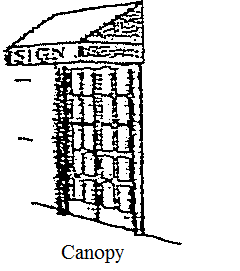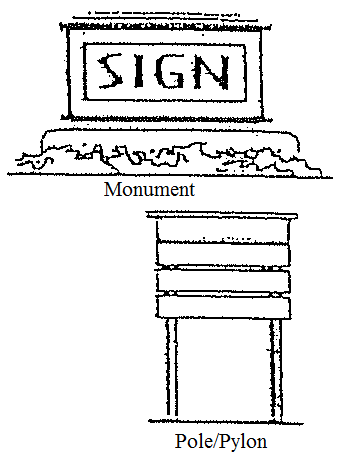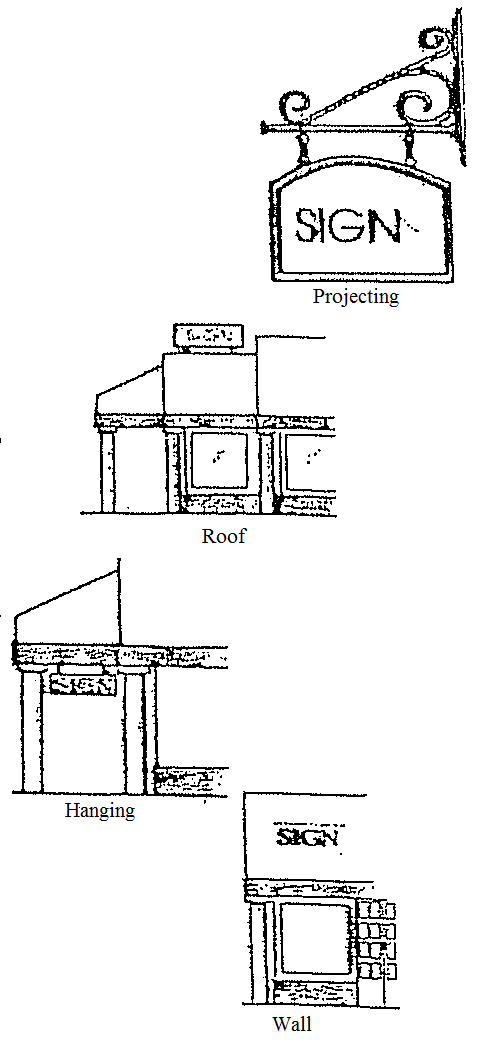18.60.030 Definitions.
For the purpose of this chapter, certain terms and words are defined as follows: words used in the present tense include the future; the word “shall” is mandatory; the word “may” is discretionary; the phrase “used for” shall include the phrases “arranged for,” “designed for,” “maintained for,” and “occupied for”; and the word “business” shall be associated with the zoning terms and activities of “permitted use” and “conditional use.” The following terms shall mean:
“Abandoned sign” means a sign or sign structure where either: (a) the sign is no longer used by the property or sign owner. Discontinuance of sign use may be shown by cessation of use of the property where the sign is located; or (b) the sign has been damaged, and repairs and restoration are not started within 45 days of the date the sign was damaged, or are not diligently pursued, once started.
“Accessory sign” means signage which is an integral part of outdoor display structures associated with a commercial or industrial use such as soft drink machines, gas pump, newspaper dispensers, and other similar structures.
“Alteration” means any change in the size, shape, method of illumination, construction or supporting structure of a sign.
Area (of a Sign).
(1) Projecting, Portable and Freestanding. The area of the sign shall be measured as follows: The area around and enclosing the perimeter of the cabinet or module shall be totaled to determine the aggregate sign area. If the sign is composed of two or more sign cabinets or modules, the area enclosing the entire perimeter of all cabinets and/or modules within a single, continuous geometric figure shall be the area of the sign. The perimeter of measurable area shall not include embellishments such as pole covers, framing, decorative roofing, etc.; provided, that there is no written copy of such embellishments. All face areas of any multi-faced sign shall be counted in calculating its area. For a double-faced sign in a single cabinet, only the area of one face is counted.
(2) Wall Signs. The area around or enclosing each sign cabinet, or where sign cabinets are not used, the area shall be that within a single, continuous perimeter composed of any straight line geometric figure which encloses the extreme limits of the message.
“Awning” means a secondary covering attached to the exterior wall of a building. The location of an awning on a building may be above a window, a door or over a sidewalk. An awning is often painted with information as to the name of the business, thereby acting as a sign in addition to providing protection from weather.
“Balloon sign” means a sign made from a nonporous bag of tough light material normally filled with heated air or a gas lighter than air so as to rise and float and displaying graphics, symbols and/or written copy.
“Banner sign” means a sign made of fabric or any nonrigid material with no enclosing framework.
“Canopy” means an awning supported by at least two columns. A canopy is able to extend further from a building than an awning, as in the case of an entrance to a restaurant or retail store.

“Changeable copy sign (electronic)” means a sign on which the copy changes electronically.
“Changeable copy sign (manual)” means a sign on which copy is changed manually in the field, e.g., the panel permanently affixed as part of a larger sign, commonly used to advertise specials for commercial businesses.
“Clearance (of a sign)” means the vertical distance measured from the lowest point of the sign to the natural surface grade beneath the sign.
“Copy” means the message on a sign surface in either permanent or removable letter form.
“Double-face sign” means a sign with advertising on two faces wherein the faces are parallel or within 10 degrees of parallel.
“Face (of a sign)” means the area of a sign on which the advertising is placed.
“Festoons” means a string of ribbons, tinsel, small flags or pinwheels.
“Flashing sign” means a sign which contains an intermittent or sequential flashing light source used primarily to attract attention. Does not include electronic changeable copy signs or signs which, through reflection or other means, create an illusion of flashing of intermittent light.
“Freestanding sign” means a sign supported upon the ground by a frame, pole(s), or other support structure which is not attached to any building. A freestanding sign shall count as one sign, even if it has two or more faces.
(1) “Monument” means a freestanding sign of which the entire bottom of the sign is generally in contact with or in close proximity to the ground. Does not include pole or pylons signs.
(2) “Pylon sign” means a freestanding sign, usually double-faced, mounted on one or two supports above ground level. Also referred to as a pole sign.

“Frontage” means the length of the property line of a lot or parcel along a public right-of-way on which it borders.
“Hazardous sign” means a sign which is detrimental to the public safety, including but not limited to any sign that has a design, color or lighting which may be mistaken for a traffic light, signal or directional sign; any sign which is located in such a manner as to obstruct free and clear vision to motorists or pedestrians at intersections and driveways; any sign which, because of its location, would prevent free ingress to or egress from any door, window, or fire escape; any sign that is attached to a standpipe or fire escape; any sign which has lighting which temporarily blinds or impairs one’s vision; or any sign which is in a leaning, sagging, fallen, decayed, deteriorated or other unsafe condition.
“Height (of a sign)” means the vertical distance measured from the highest point of the sign to the natural surface grade beneath the sign.
“Illuminated sign” means a sign with an artificial light source incorporated internally (i.e., direct illumination), or with an external light source directed to illuminate the exterior surface of the sign (i.e., indirect illumination). This definition includes signs with light sources which are disconnected from power.
“Incidental sign” means a small sign, emblem or decal typically used to inform the public of goods, facilities or services available on the premises (e.g., a credit card sign or a sign indicating hours of business).
“Landmark sign” means a sign found to be of historical or local significance by the planning commission.
“Maintenance” means, for the purposes of this chapter, the cleaning, painting, repair or replacement of defective parts of a sign, or to achieve a change in sign face, in a manner that does not alter the basic design or structure of the sign.
“Marquee” means a permanent roof-like projection from a building above the building entrance.
“Mounted sign” means a sign permanently attached to a building.
(1) “Canopy sign” means a sign painted on, printed on, or attached flat against the surface of a canopy or awning.
(2) “Projecting sign” means a sign, other than a flat wall sign, which is attached to and projects from a building wall or other structure not specifically designed to support the sign.
(3) “Roof sign” means any mounted sign that projects above the top of a wall, eave or parapet.
(4) “Hanging sign” means a sign that hangs beneath a marquee, canopy or awning and is perpendicular to the building face.
(5) “Wall sign” means a sign attached parallel to and extending not more than 12 inches from the wall of a building. This definition includes painted, individual letters and cabinet signs.

“Moving sign” means a sign which uses mechanized movement (e.g., rotation) to attract attention, depict action or to create a special effect or scene (and includes dancing inflatable displays).
“Multi-tenant complex” means a development consisting of one or more lots and two or more businesses sharing appurtenant facilities, such as driveways, parking and pedestrian walkways, and is designed to provide varied products and services at a single location.
“Nonconforming sign” means an existing sign, lawful before enactment of this chapter, which does not conform to the requirements of this chapter.
“Permanent sign” means a sign structurally affixed to the ground or to a building and intended for display for more than 12 consecutive months.
“Portable sign” means a sign not permanently affixed to a sign structure, a building or the ground.
“Sign” means any device, structure, fixture, placard, and any related support structure erected for the purpose of displaying graphics, symbols, and/or written copy designed specifically for the purpose of advertising or identifying any business, person, institution, commodity, service, entertainment, or activity.
“Site” means a lot, parcel or tract of land under common ownership and/or developed together as a single development site, regardless of how many uses occupy the site.
“Temporary sign” means a sign or advertising display constructed of fabric, vinyl, paper, cardboard, plywood, or other light materials, with or without a frame, not permanently attached to a building, structure or ground intended to be displayed for a specific and limited period of time. A sign that will become obsolete after the occurrence of an event or series of events. Temporary signs typically include, but are not limited to, portable signs, event signs, for sale and lease signs, garage sale signs and political campaign signs.
“Video sign” means an electronic changeable copy sign providing information in both a horizontal and vertical format (as opposed to linear), and having the capacity to create continuously changing sign copy in a wide spectrum of colors, shades and light intensities.
“Window sign” means an unlighted sign installed inside a window or painted on a window and intended to be viewed from the outside. (Ord. 466 § 2, 2012)